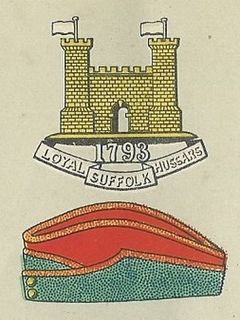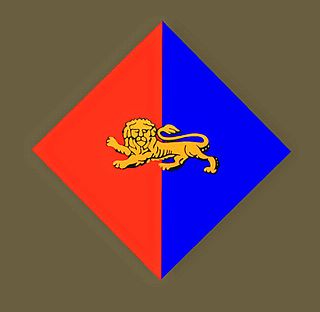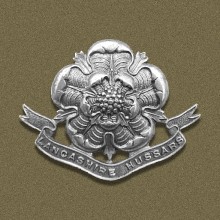 W
WThis list of regiments of the Royal Artillery covers the period from 1938, when the RA adopted the term 'regiment' rather than 'brigade' for a lieutenant-colonel's command comprising two or more batteries, to 1947 when all RA regiments were renumbered in a single sequence.
 W
WThe 6th County of London Brigade, Royal Field Artillery was a new unit formed when Britain's Territorial Force was created in 1908. Its origin lay in Artillery Volunteer Corps formed in the Surrey suburbs of South London in the 1860s, which had later been incorporated into a larger London unit. Together with its wartime duplicate it served on the Western Front, at Salonika and in Palestine during World War I. Converted to the anti-tank role just before World War II it saw widely varied service during the war, while its duplicate regiment landed on D-Day. The regiment continued in the postwar Territorial Army until 1961.
 W
WThe Queen's Own Worcestershire Hussars was a Yeomanry regiment of the British Army. First raised in 1794, it participated in the Second Boer War and World War I as horsed cavalry before being converted to an anti-tank regiment of the Royal Artillery for service in World War II. In 1956 it was amalgamated with the Warwickshire Yeomanry to form the Queen's Own Warwickshire and Worcestershire Yeomanry. The lineage is maintained by B Squadron, part of The Royal Yeomanry.
 W
WThe Duke of Yorks Own Loyal Suffolk Hussars was a Yeomanry regiment of the British Army. Originally formed as a volunteer cavalry force in 1793, it fought in the Second Boer war as part of the Imperial Yeomanry. In the World War I the regiment fought at Gallipoli, in Palestine and on the Western Front. The unit was subsequently converted into a Royal Artillery unit, serving in the anti-tank role North Africa, Italy and France during World War II. The lineage is maintained by No. 677 Squadron AAC.
 W
WThe 56th Anti-Tank Regiment was a Territorial Army unit of the British Army's Royal Artillery (RA), which converted from the 4th Battalion, King's Own Royal Regiment (Lancaster). During the Second World War, it first served with the 42nd Division in the Battle of France and Dunkirk evacuation in May–June 1940. In 1942, it was sent to join the 70th Infantry Division in India, where it was converted into a Light Anti-Aircraft/Anti-Tank Regiment. In this guise, it served in the Burma Campaign, mainly with the 5th Indian Infantry Division. It reconverted to the anti-tank role in late 1944 and in June 1945 it returned to India as a training unit. It continued serving in the TA postwar until 1961, when it re-merged into the King's Own.
 W
WThe East Surrey Regiment was a line infantry regiment of the British Army in existence from 1881 until 1959. The regiment was formed in 1881 under the Childers Reforms by the amalgamation of the 31st (Huntingdonshire) Regiment of Foot, the 70th (Surrey) Regiment of Foot, the 1st Royal Surrey Militia and the 3rd Royal Surrey Militia.
 W
WThe Duke of Wellington's Regiment was a line infantry regiment of the British Army, forming part of the King's Division.
 W
WThe 6th Battalion, Hampshire Regiment was an infantry battalion of the British Army. Part of the Volunteer Force, later the Territorial Force, the battalion was part of the Hampshire Regiment and recruited from Portsmouth, Hampshire. It served as infantry during World War I and as a Royal Artillery regiment during and after World War II.
 W
WThe 6th County of London Brigade, Royal Field Artillery was a new unit formed when Britain's Territorial Force was created in 1908. Its origin lay in Artillery Volunteer Corps formed in the Surrey suburbs of South London in the 1860s, which had later been incorporated into a larger London unit. Together with its wartime duplicate it served on the Western Front, at Salonika and in Palestine during World War I. Converted to the anti-tank role just before World War II it saw widely varied service during the war, while its duplicate regiment landed on D-Day. The regiment continued in the postwar Territorial Army until 1961.
 W
WThe Queen's Own Oxfordshire Hussars was the designated name of a Yeomanry regiment of the British Army formed in 1794. It saw service in the Second Boer War with 40 and 59 Companies of the Imperial Yeomanry and also served in Belgium and France during the Great War. In 1922, the regiment became part of the Royal Artillery. The lineage is maintained by 142 Vehicle Squadron Royal Logistic Corps.
 W
WThe Norfolk Yeomanry was a volunteer cavalry (Yeomanry) regiment of Britain's Territorial Army accepted onto the establishment of the British Army in 1794. After seeing action in the Second Boer War, it served dismounted at Gallipoli, in Palestine and on the Western Front during the First World War. Between the wars it converted to the Royal Artillery (TA), and served as an anti-tank regiment in France, the Western Desert, Italy and North West Europe during the Second World War. After the war it served as a TA air defence unit and then as an Army Air Corps unit.
 W
WThe 56th Anti-Tank Regiment was a Territorial Army unit of the British Army's Royal Artillery (RA), which converted from the 4th Battalion, King's Own Royal Regiment (Lancaster). During the Second World War, it first served with the 42nd Division in the Battle of France and Dunkirk evacuation in May–June 1940. In 1942, it was sent to join the 70th Infantry Division in India, where it was converted into a Light Anti-Aircraft/Anti-Tank Regiment. In this guise, it served in the Burma Campaign, mainly with the 5th Indian Infantry Division. It reconverted to the anti-tank role in late 1944 and in June 1945 it returned to India as a training unit. It continued serving in the TA postwar until 1961, when it re-merged into the King's Own.
 W
WThe East Surrey Regiment was a line infantry regiment of the British Army in existence from 1881 until 1959. The regiment was formed in 1881 under the Childers Reforms by the amalgamation of the 31st (Huntingdonshire) Regiment of Foot, the 70th (Surrey) Regiment of Foot, the 1st Royal Surrey Militia and the 3rd Royal Surrey Militia.
 W
WThe Duke of Wellington's Regiment was a line infantry regiment of the British Army, forming part of the King's Division.
 W
WThe 6th Battalion, Hampshire Regiment was an infantry battalion of the British Army. Part of the Volunteer Force, later the Territorial Force, the battalion was part of the Hampshire Regiment and recruited from Portsmouth, Hampshire. It served as infantry during World War I and as a Royal Artillery regiment during and after World War II.
 W
WThe 56th Anti-Tank Regiment was a Territorial Army unit of the British Army's Royal Artillery (RA), which converted from the 4th Battalion, King's Own Royal Regiment (Lancaster). During the Second World War, it first served with the 42nd Division in the Battle of France and Dunkirk evacuation in May–June 1940. In 1942, it was sent to join the 70th Infantry Division in India, where it was converted into a Light Anti-Aircraft/Anti-Tank Regiment. In this guise, it served in the Burma Campaign, mainly with the 5th Indian Infantry Division. It reconverted to the anti-tank role in late 1944 and in June 1945 it returned to India as a training unit. It continued serving in the TA postwar until 1961, when it re-merged into the King's Own.
 W
WThe 5th Battalion, Devonshire Regiment, was a part-time unit of the British Army recruited in the county of Devon. It was formed in the Territorial Force in 1908 by amalgamating two existing Volunteer Battalions of the Devonshire Regiment. The battalion served in India and fought in Palestine and on the Western Front during World War I. In World War II it provided two anti-tank artillery units, which served in Tunisia, Italy and North West Europe. They were both merged into other Devonshire units in 1950.
 W
WThe 5th Battalion, Devonshire Regiment, was a part-time unit of the British Army recruited in the county of Devon. It was formed in the Territorial Force in 1908 by amalgamating two existing Volunteer Battalions of the Devonshire Regiment. The battalion served in India and fought in Palestine and on the Western Front during World War I. In World War II it provided two anti-tank artillery units, which served in Tunisia, Italy and North West Europe. They were both merged into other Devonshire units in 1950.
 W
WThe Manchester Regiment was a line infantry regiment of the British Army in existence from 1881 until 1958. The regiment was created during the 1881 Childers Reforms by the amalgamation of the 63rd Regiment of Foot and the 96th Regiment of Foot as the 1st and 2nd battalions; the 6th Royal Lancashire Militia became the 3rd (Reserve) and 4th battalions and the Volunteer battalions became the 5th, 6th, 7th, 8th, 9th and 10th battalions.
 W
WThe Liverpool Scottish, known as "the Scottish", was a unit of the British Army, part of the Army Reserve, raised in 1900 as an infantry battalion of the King's. The Liverpool Scottish became affiliated to the Queen's Own Cameron Highlanders in the 1920s and formally transferred to the regiment in 1937 with its identity preserved. Reflecting the Territorial Army's decline in size since the late 1940s, the battalion was reduced to a company in 1967, then to a platoon of "A" (King's) Company, King's and Cheshire Regiment in 1999. In 2006, the company was incorporated into the 4th Battalion, Duke of Lancaster's Regiment.
 W
WThe King's Own Royal Regiment (Lancaster) was a line infantry regiment of the British Army. It served under various titles and fought in many wars and conflicts, including both the First and the Second World Wars, from 1680 to 1959. In 1959, the regiment was amalgamated with the Border Regiment to form the King's Own Royal Border Regiment.
 W
WThe Argyll and Sutherland Highlanders was a line infantry regiment of the British Army that existed from 1881 until amalgamation into the Royal Regiment of Scotland on 28 March 2006.
 W
WThe Gordon Highlanders was a line infantry regiment of the British Army that existed for 113 years, from 1881 until 1994, when it was amalgamated with the Queen's Own Highlanders to form the Highlanders. Although the 'Gordon Highlanders' had existed as the 92nd Regiment of Foot since 1794, the actual 'Gordon Highlanders Regiment' was formed in 1881 by amalgamation of the 75th (Stirlingshire) Regiment of Foot and 92nd Regiment of Foot.
 W
WThe Argyll and Sutherland Highlanders was a line infantry regiment of the British Army that existed from 1881 until amalgamation into the Royal Regiment of Scotland on 28 March 2006.
 W
WThe 4th Lancashire Artillery Volunteers, later renamed to the 4th West Lancashire Brigade, known as 'The Old 4th', was a part-time unit of the British Army's Royal Artillery founded in Liverpool in 1859. It served on the Western Front during World War I, one of its members winning the Victoria Cross at Cambrai. Between the world wars the unit pioneered mechanical traction methods. During World War II it formed three regiments that saw action at Dunkirk, in East Africa, on Crete, at Tobruk, in Burma, and in the final campaigns in Italy and North West Europe. It continued in the post-war Territorial Army until 1973.
 W
WThe Gordon Highlanders was a line infantry regiment of the British Army that existed for 113 years, from 1881 until 1994, when it was amalgamated with the Queen's Own Highlanders to form the Highlanders. Although the 'Gordon Highlanders' had existed as the 92nd Regiment of Foot since 1794, the actual 'Gordon Highlanders Regiment' was formed in 1881 by amalgamation of the 75th (Stirlingshire) Regiment of Foot and 92nd Regiment of Foot.
 W
WThe Northumberland Hussars was a Yeomanry regiment of the British Army, transferred to the Royal Artillery for the duration the Second World War. It was disbanded as an independent Territorial Army unit in 1967, a time when the strength of the Territorial Army was greatly reduced. The regiment's name lives on in the title of the command and support squadron of the Queen's Own Yeomanry (QOY), a Formation Reconnaissance Regiment based in Newcastle upon Tyne.
 W
WThe 103rd Anti-Tank Regiment, Royal Artillery was a short-lived unit of the British Army during World War II. Initially raised as an infantry battalion of the South Staffordshire Regiment in 1940, it transferred to the Royal Artillery in late 1942 after serving for two years defending the coast of Norfolk. During 1943 it was broken up to provide independent air-landing batteries for 6th Airborne Division.
 W
WThe 1st Devonshire Artillery Volunteers and its successor units served in the British Army's Reserve Forces from 1859 to 1961. During World War I it carried out garrison duty in British India but went on to see active service in the Third Anglo-Afghan War. Converting to an air defence role before World War II its units participated in the Norwegian campaign and the Dunkirk evacuation, the Battle of Britain and then the campaigns in North Africa, Italy, and Burma
 W
WThe Lancashire Hussars was a British Army unit originally formed in 1798. It saw action in the Second Boer War, the First World War and the Second World War. In 1969, the regiment reduced to a cadre and the Yeomanry lineage discontinued.
 W
WThe 6th County of London Brigade, Royal Field Artillery was a new unit formed when Britain's Territorial Force was created in 1908. Its origin lay in Artillery Volunteer Corps formed in the Surrey suburbs of South London in the 1860s, which had later been incorporated into a larger London unit. Together with its wartime duplicate it served on the Western Front, at Salonika and in Palestine during World War I. Converted to the anti-tank role just before World War II it saw widely varied service during the war, while its duplicate regiment landed on D-Day. The regiment continued in the postwar Territorial Army until 1961.
 W
WThe Metropolitan Artillery Volunteers was a part-time unit of the British Volunteer Force formed in the London area in 1861. It was designated the 3rd Middlesex Artillery Volunteers and went on to become the 5th London Brigade, Royal Field Artillery in the Territorial Force. It provided two active service units in World War I, which saw action on the Western Front. Just before World War II it again spun off a duplicate regiment, each taking the '5th London' subtitle. Both regiments saw widely varied service during the war. The regiment later provided an airborne artillery unit in the Territorial Army of the 1950s.
 W
WThe Queen's Own Worcestershire Hussars was a Yeomanry regiment of the British Army. First raised in 1794, it participated in the Second Boer War and World War I as horsed cavalry before being converted to an anti-tank regiment of the Royal Artillery for service in World War II. In 1956 it was amalgamated with the Warwickshire Yeomanry to form the Queen's Own Warwickshire and Worcestershire Yeomanry. The lineage is maintained by B Squadron, part of The Royal Yeomanry.
 W
WThe Duke of Yorks Own Loyal Suffolk Hussars was a Yeomanry regiment of the British Army. Originally formed as a volunteer cavalry force in 1793, it fought in the Second Boer war as part of the Imperial Yeomanry. In the World War I the regiment fought at Gallipoli, in Palestine and on the Western Front. The unit was subsequently converted into a Royal Artillery unit, serving in the anti-tank role North Africa, Italy and France during World War II. The lineage is maintained by No. 677 Squadron AAC.
 W
WThe 56th Anti-Tank Regiment was a Territorial Army unit of the British Army's Royal Artillery (RA), which converted from the 4th Battalion, King's Own Royal Regiment (Lancaster). During the Second World War, it first served with the 42nd Division in the Battle of France and Dunkirk evacuation in May–June 1940. In 1942, it was sent to join the 70th Infantry Division in India, where it was converted into a Light Anti-Aircraft/Anti-Tank Regiment. In this guise, it served in the Burma Campaign, mainly with the 5th Indian Infantry Division. It reconverted to the anti-tank role in late 1944 and in June 1945 it returned to India as a training unit. It continued serving in the TA postwar until 1961, when it re-merged into the King's Own.
 W
WThe 6th Battalion, Hampshire Regiment was an infantry battalion of the British Army. Part of the Volunteer Force, later the Territorial Force, the battalion was part of the Hampshire Regiment and recruited from Portsmouth, Hampshire. It served as infantry during World War I and as a Royal Artillery regiment during and after World War II.